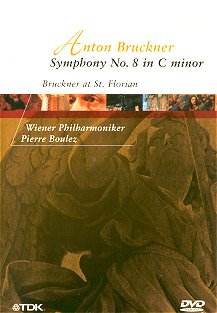Recorded at two concerts in September 1996 celebrating
the centenary of Bruckner's death, this well produced DVD captures the
experience of a special occasion. For the great baroque monastery church
of St Florian in Upper Austria is not a regular concert venue. It became
one because of its special association with the composer, who is buried
there beneath the organ, and who chose the location as the one which
meant more to him than any other in the world.
Brian Large is an experienced hand at visual presentations
of musical performances, and he directs this production admirably. There
is a good sense of space and of the occasion, with the two performances
used so discreetly that the viewer/listener is unaware of more than
one performance being used. And a very fine performance it is too, already
available and highly praised from its CD issue several months ago.
The CD sound outstrips that of this DVD, although the
latter is acceptable enough. But the volume level needs to be boosted
to allow details to make their mark and climaxes their impact. The timpani,
for example, have relatively less focus than they do on the CD.
Boulez conducts a beautifully controlled performance,
using the Haas edition of the score and avoiding extremes of phrasing
and tempi. Since as a conductor he was coming to the music for the first
time in his career, he made his own study of the score his priority,
rather than following the precedent of others. He admits as much in
the accompanying interview, which is interesting as far as it goes,
but does not show that Boulez has any special insights into Bruckner
other than as a leading practitioner of the art of conducting. It goes
to show what a good conducting technique and experience can do, especially
when there is the Vienna Philharmonic on hand to play the notes.
There are some wonderful images of St Florian, which
remains a very special place, unspoiled by the trappings of tourism
and modern society. It is easy to understand why it remained so important
to Bruckner. But the project surely missed an opportunity and took an
easy way out, when a more details look at the place could have been
offered, with some documentary material on Bruckner's association with
it. Merely getting Boulez to give an interview seems like an easy option.
The written documentation is weak, and includes one
extraordinary howler. Boulez quite rightly opts for Bruckner's 1890
revised version (the first version having been completed three years
earlier). The insert notes, which emanate from Japan, state: 'The original
adaptation of the score was published by Leopold Nowak in 1890 and later
reworked by Robert Haas in the 1930s.' Oh dear. In fact Nowak was born
in 1904, fourteen years after Bruckner's second version of the symphony
was completed. The Nowak edition of the score was actually published
in 1955.
The Boulez performance is one to be reckoned with.
The Vienna Philharmonic Orchestra plays as well as one would expect
them to play, and an advantage they offer is the longer bore horns which
Bruckner himself expected. The blending of horns with Wagner tubas is
a feature of the work, and of the performance too, though there were
a couple of occasions, including the magnificent conclusion of the work,
when the recording might have given horn tone greater prominence. But
the interpretation is compelling and valid. My only quibble relates
to the trio of the scherzo, in which the tempo seems rapid and the phrasing
straight-laced. More rubato might have brought more character.
There are many fine things to be experienced, and subtleties
emerge most naturally. Never have Bruckner's harps made a more telling
contribution, and they certainly add a special dimension to the great
climax of the Adagio. The revised coda of the first movement, an addition
which Bruckner entitled 'Totenuhr' (Death Watch) is suitably sombre
and atmospheric. Boulez, however, admits in the interview that he simply
followed the notes in the score to achieve this effect. The visual aspect
certainly takes up the challenge of this imagery, however, cutting to
the crypt and featuring images of skulls and bones. But nothing in the
accompanying booklet notes explains why this was done, and that is typical
of the sloppy approach to this aspect of the production. In fact this
is much the weakest aspect of it.
It would be wrong to dwell on the less successful aspects
of this DVD package, however. For the music is beautifully played, the
composer is well served and the orchestra sounds splendid. At the same
time the visual imagery and camera work respond to the nobility which
lies at the heart of Bruckner's conception.
Terry Barfoot


